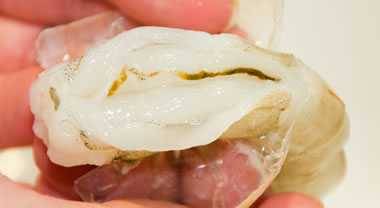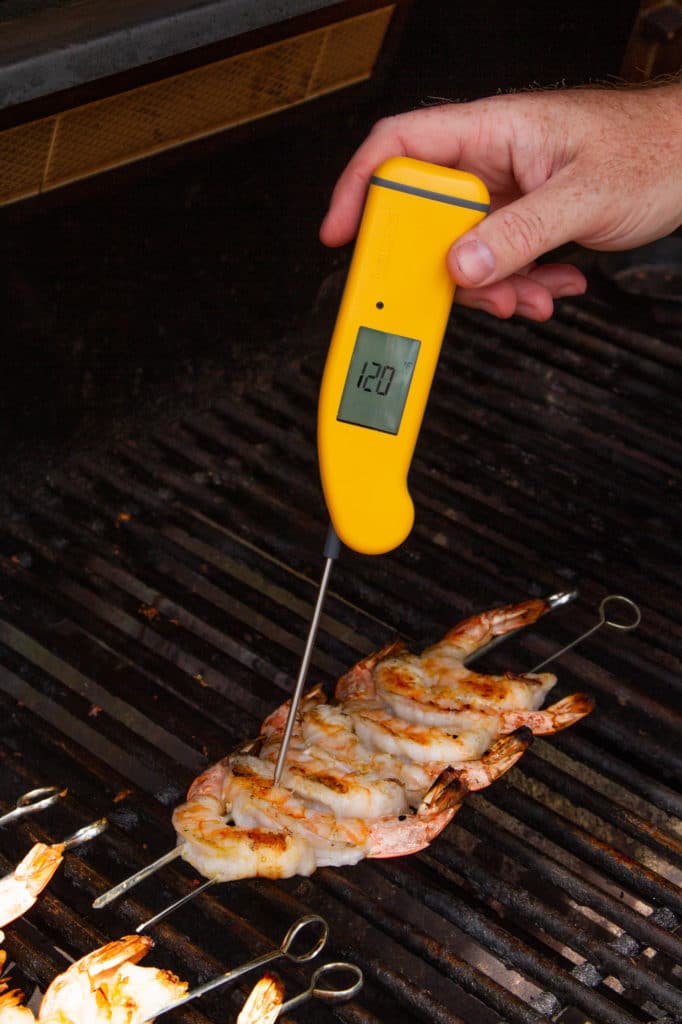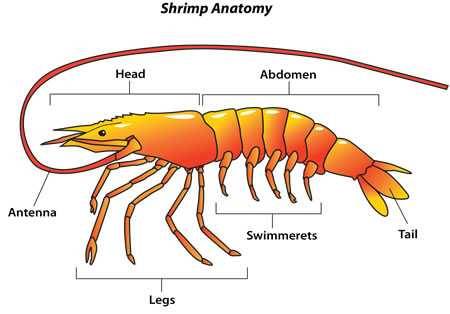There are many types of shrimp and prawns, and in the wild they are among the most important animals in the ocean food chain. Fish love them, whales love them, and humans love them.
Related to lobster, crawfish, and crabs, there are at least half a dozen common varieties harvested for food, and some are even farmed. Best of all, they don’t require much prep, and they cook quickly. You can boil them if you wish, but you know they are better grilled!
Buying shrimp
As with so many other seafoods, shrimp caught and flash frozen at sea or on the docks will usually be better than raw shrimp shipped cross country and left sitting in the grocery store for days. Flash freezing at very low temps keeps the ice crystals small so they don’t destroy as many cell walls as slow frozen shrimp. This prevents moisture loss. Just defrost frozen shrimp in the fridge.
Shrimp have no bones. They have an outer shell called an exoskeleton made from a sturdy variety of compounds. For culinary purposes, shrimp has four parts: (1) The head and legs which go all the way back to the end of the large solid shell called the carapace, (2) the abdomen, which is the good stuff, (3) the swimmerets, and (4) the tail.
Shrimp come in three forms: (1) Whole, (2) headless with shell, swimmerets, and tail attached, and (3) head, shell, swimmerets, and tail removed.
And they come in many sizes. “Jumbo shrimp” is among the goofiest terms in the culinary world. Shrimp are sold by the pound, and headless shrimp are measured by the number of shrimp per pound. Shrimp labeled 31/35 means there are 31 to 35 per pound and should be called medium but are sometimes called large. The size names can vary from merchant to merchant sometimes, and tend to be inflated like condom sizes. 16/20 are called jumbo, but I consider them large. U-12 and U-10, meaning under 12 or under 10 per pound, are called colossal or super colossal. For this reason, better recipes give you the count per pound rather than a size name.
All this reminds me of the time feminist pioneer Gloria Steinem testified before Congress on birth control and advocating that the smallest condom size be “large” saying that she just couldn’t envision men asking a pharmicist for a small.
Similarly, I recommend large shrimp. Small shrimp can be tedious to clean. Large shrimp are easier. Small shrimp are cooked through before they get dark on the outside. Large shrimp take longer and benefit from dark grill marks. Small shrimp are easy to overcook. Large shrimp are easier to monitor and cook properly. I recommend large shrimp, 16/20 or larger.
Leave the shell on, remove the head and vein
Shrimp shells protect the delicate meat from overcooking and, because they contain chitin (pronounced KITE-in), which is rich in sugars, they contribute flavor to the meat. If you marinate shell-on shrimp, the shell blocks much of the marinade from reaching the abdomen meat, and shrimp meat absorbs more marinade than almost any other meat. If there are a lot of spices, herbs, or marinade on the outside of the shells, however, they get on your fingers and then on the meat as you eat. Your fingers become like brushes, a part of the seasoning process.
I recommend cooking shell on, but this is problematic because the digestive tract, called the vein for some odd reason, sometimes contains grit, and many people find it unappetizing. You can buy shrimp that are already cleaned, with heads, swimmerets, shells, veins, and tails removed, but they cost more because this can only be done by hand. Doing it yourself is easy. You can leave the shell on and still remove the vein, thus exposing more meat to seasoning or marinade, and this is the best of all worlds.
Some people even eat the shells, swimmerets, and tails if they are soft enough. They are tasty, covered with seasonings, smoke from the grill, and laten with nutrients. This can be dangerous because there is a pointy tip called the telson between the two fins on the tail. If you are a shell eater, snip off the point of the telson before cooking so it won’t lodge in your throat and interrupt dinner with a trip to the emergency room.
Start by breaking off the heads at the point where the large solid shell, called the carapace, meets the smaller segmented shell sections of the abdomen. Then rip off the legs. If you wish, leave the tails on. They make nice handles when eaten with your fingers or when dunking in sauce or melted butter. For stand-up cocktail parties, remove the tails so people don’t have to figure out what to do with them after they eat the shrimp.

The vein runs along the convex side, the back of the abdomen. Sometimes it is hard to see, especially if the shrimp hadn’t eaten much before being killed. Sometimes it is black when filled.

With a scissors cut the shell all along the center of the back opposite the legs all the way to the tail.

With a sharp paring knife, cut through the flesh until you see the vein. Cut from the head end all the way to the tail.

When the vein is exposed, slip the tip of your knife under it and gently lift. It should all come out in one piece. If it breaks, repeat the action. Now rinse and pat them dry. Some recipes call for butterflied shrimp. After you remove the vein, just extend the cut you made a little deeper, but not all the way and spread the two halves open.
Shell on is best for sit down affairs on picnic tables covered with newspaper. It is sloppy and not a good idea for those formal black tie and ball gown affairs you like to throw. For these, I recommend shelled and cleaned.
Grilling shrimp
A very light dusting of baking soda raises the pH and that helps with browning as does a very light dusting of sugar. Be careful, too much baking soda can impart a slight metallic flavor, and too much sugar can burn. Pat the shrimp dry with paper towels first. If the surface is too wet it won’t brown. You don’t need to salt them, they should have enough salt in them already. Brush the shrimp with vegetable oil or melted butter to prevent sticking. I like to mix some spices in the oil. My Memphis Dust is my favorite but a blend of freshly crushed garlic and some chipotle powder is about all you need. I like to use a grill topper which also helps with browning. But you can use skewers. If you use just one, they will spin and not flip, so use two to hold them steady. Grill over direct heat, not full blast, about three to four minutes on each side depending on the thickness of the shrimp. Cook until the shrimp hits about 130°F and it turns bright pink on the outside and pearly white in the center and they get some grill marks. Be careful not to overcook shrimp!

Save the heads, shells, and tails
If you wish, you can save the heads, shells, and tails and boil them to make shrimp stock. Start by sautéing them in butter until they turn pink. The oils in butter extract flavor. Then cover with 2″ or so of water and simmer for a few hours reducing the volume. Taste until it is the strength you want. Then season with salt, herbs, whatever. You’ll then have a rich shrimp flavored buttery stock that you can use as a base for sauces or soups or for boiling rice or couscous.



High quality websites are expensive to run. If you help us, we’ll pay you back bigtime with an ad-free experience and a lot of freebies!
Millions come to AmazingRibs.com every month for high quality tested recipes, tips on technique, science, mythbusting, product reviews, and inspiration. But it is expensive to run a website with more than 2,000 pages and we don’t have a big corporate partner to subsidize us.
Our most important source of sustenance is people who join our Pitmaster Club. But please don’t think of it as a donation. Members get MANY great benefits. We block all third-party ads, we give members free ebooks, magazines, interviews, webinars, more recipes, a monthly sweepstakes with prizes worth up to $2,000, discounts on products, and best of all a community of like-minded cooks free of flame wars. Click below to see all the benefits, take a free 30 day trial, and help keep this site alive.
Post comments and questions below
1) Please try the search box at the top of every page before you ask for help.
2) Try to post your question to the appropriate page.
3) Tell us everything we need to know to help such as the type of cooker and thermometer. Dial thermometers are often off by as much as 50°F so if you are not using a good digital thermometer we probably can’t help you with time and temp questions. Please read this article about thermometers.
4) If you are a member of the Pitmaster Club, your comments login is probably different.
5) Posts with links in them may not appear immediately.
Moderators